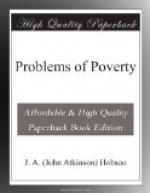2. The great fall of prices, due to cheapening of production and of transport during the last twenty years, benefits the poor far less than the rich. For, while the prices of most comforts and luxuries have fallen very greatly, the same is not true of most necessaries. The gain to the workers is chiefly confined to food prices, which have fallen some 40 per cent since 1880. Taking the retail prices of foods consumed by London working-class families we find that since 1880 the price of flour has fallen about 60 per cent., bread falling a little more than half that amount; the prices of beef and mutton have fallen nearly to the same extent as flour, though bacon stands in 1903 just about where it stood in 1880. Sugar exhibits a deep drop until 1898, rising afterwards in consequence of the war tax and the Sugar Convention; tea shows a not considerable drop. Other groceries, such as coffee and cocoa, and certain vegetables are cheaper. A careful inquiry into clothing shows a trifling fall of price for articles of the same quality, while the introduction of cheaper qualities has enabled workers to effect some saving here. Against these must be set a slight rise in price of dairy produce, a considerable rise in fuel, and a large rise in rent. A recent estimate of the Board of Trade, having regard to food, rent, clothing, fuel, and lighting as chief ingredients of working-class expenditure, indicates that 100 shillings will in 1900 do the work for which 120 shillings were required in 1880. The great fall of prices has been in the period 1880-1895, since then prices all round (except in clothing) show a considerable rise.
In turning from the working-classes as a whole to the poor, it becomes evident that the most substantial benefit they have received from falling prices is cheap bread. Cheap groceries and lighting are also gains, though it must be remembered that the modes of purchase to which the very poor are driven to have recourse minimize these gains. On clothes the poor spend a very small proportion of their incomes, the very poor virtually nothing. In the case of the lowest classes of the towns, it is probable that the rise in rents offsets all the advantages of cheapened prices for other commodities.
The importance of the bearing of this fact is obvious. Even were it clearly proved that the wages of the working-classes were increasing faster in proportion than the incomes of the wealthier classes, it would not be thereby shown that the standard of comfort in the former was rising as fast as the standard of comfort in the latter. If we confine the term “poor” to the lower grades of wage-earners, it would probably be correct to say that the riches of the rich had increased at a more rapid rate than that at which the poverty of the poor had diminished. Thus the width of the gap between riches and poverty would be absolutely greater than before. But, after all, such absolute measurements as these are uncertain, and have little




